Many alarmist quotes suggest cyber threats are unstoppable or imminent, but the truth is, most breaches involve planning and detection, not instant disaster. While no system is completely invulnerable, proactive security measures like regular updates, encryption, and employee training greatly reduce risks. Claims of exponential attack increases or total device vulnerability are often exaggerated, and experts work tirelessly to protect us. To understand how to separate hype from reality and strengthen your defenses, explore the insights below.
Key Takeaways
- Many alarmist quotes exaggerate cyber threat costs; actual risks are often manageable with proactive defenses.
- Recognizing that no system is invulnerable encourages focus on resilience rather than false security.
- Better detection and reporting contribute to perceived increases in attacks, not necessarily a rise in actual threats.
- Emphasizing comprehensive security strategies and employee training reduces vulnerabilities more effectively than fear-based claims.
- Understanding cybersecurity limitations helps prioritize practical measures over sensationalized warnings.
The Reality Behind “Cyberwarfare Is Inevitable”
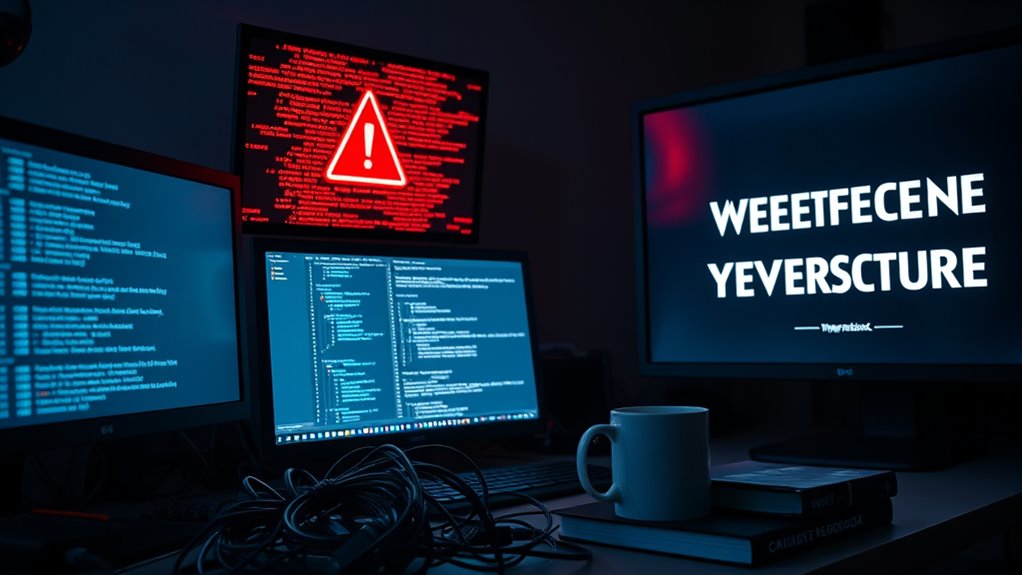
Many experts argue that cyberwarfare is unavoidable, but this belief can lead organizations to accept breaches as inevitable. Instead of surrendering, focus on strengthening your defenses with robust encryption protocols. Proper encryption makes sensitive data unreadable to cybercriminals, reducing the impact of attacks. However, don’t forget that insider threats remain a significant vulnerability; employees or contractors with access can intentionally or unintentionally cause harm. Implement strict access controls, regular training, and monitoring to minimize this risk. Recognizing that threats exist doesn’t mean you should accept defeat. Proactive measures, like updating encryption standards and managing insider risks, empower you to defend your organization effectively. Staying vigilant and prepared is your best strategy against the perceived inevitability of cyberwarfare. Additionally, understanding threat detection methods can help you identify vulnerabilities before they are exploited.
Debunking the “Your Data Will Be Stolen in Minutes” Myth
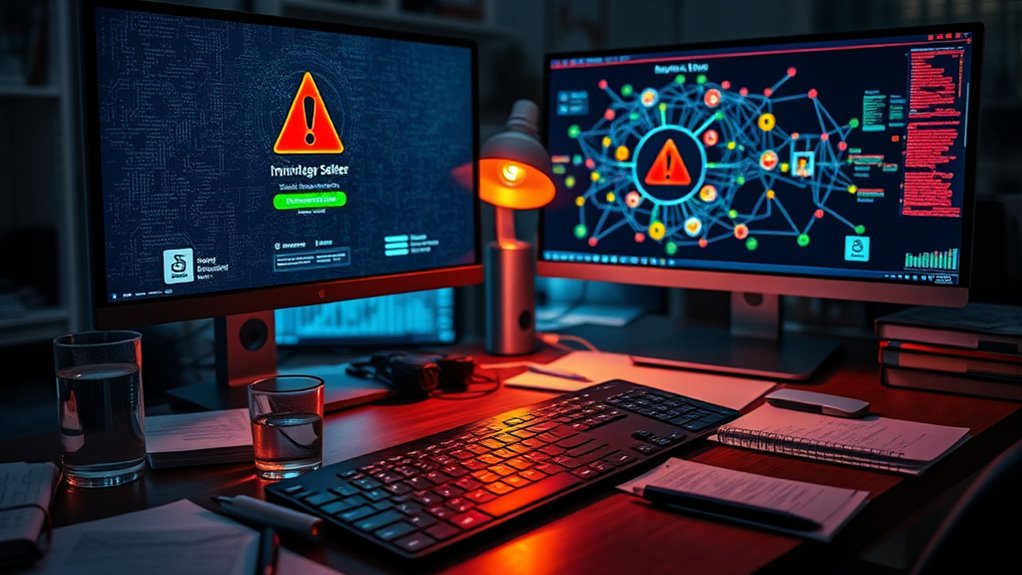
While quick breaches do happen, most attacks involve prolonged planning, giving you a chance to detect and prevent them, especially through penetration testing that identifies vulnerabilities before exploitation.
The Truth About “Every Business Will Suffer a Breach”
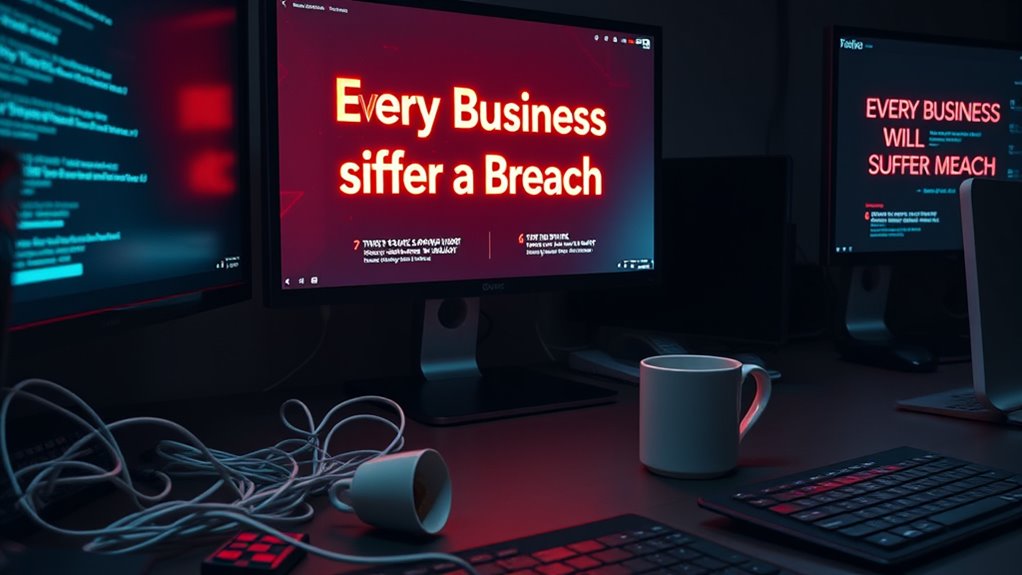
Many believe every business will eventually suffer a breach, but the reality is more nuanced. Breach frequency varies, and smart resilience strategies can considerably reduce your risk. Understanding your actual threat level helps you focus your defenses where they matter most. For example, implementing cybersecurity measures can significantly lower the likelihood of a successful attack.
Breach Frequency Reality
Is it true that every business will inevitably face a breach? Not necessarily. While phishing scams and insider threats are common attack vectors, the frequency of breaches varies widely. Some organizations experience repeated incidents, but many prevent breaches through strong security practices. It’s a misconception that every business is destined to suffer a breach; proactive measures make a significant difference. The reality is that breach frequency depends on your security posture and awareness. Educating employees about phishing scams, implementing strict access controls, and monitoring insider activity reduce risks. Although breaches are more prevalent than ever, they’re not guaranteed. Implementing effective security measures can greatly decrease the likelihood of an attack and protect your organization from the most common methods. Focus on strengthening defenses rather than assuming catastrophe is unavoidable, and you’ll better protect your organization from the most common attack methods.
Business Resilience Strategies
Understanding that not every business will face a breach shifts the focus from fear to preparedness. You can build resilience by investing in employee training, ensuring your team recognizes phishing attempts and suspicious activities. Regular training keeps security top of mind and reduces human error, a common vulnerability. Additionally, develop a clear incident response plan that outlines steps to contain and remediate breaches quickly. Practice this plan through simulations to identify gaps and improve your reaction time. Incorporating proper training techniques can significantly enhance your staff’s ability to respond effectively. Combining employee awareness with a well-defined incident response strategy minimizes damage and speeds recovery. Remember, resilience isn’t just about preventing every attack but being ready to respond effectively when breaches occur. This proactive approach turns vulnerability into strength, safeguarding your business’s future.
Are We Really “One Click Away” From Disaster?

One wrong click can open the door to serious threats, but is disaster really just one step away? Understanding the true risks helps you protect your digital boundaries effectively. Trustworthiness of Patchology is an example of how transparency and certification play a role in establishing credibility, similar to verifying the authenticity of your online sources.
The Reality of Risks
Despite the common phrase that a single click can lead to disaster, the reality is more nuanced. While one risky click can cause harm, it’s often a combination of factors, not just a single mistake. Employee awareness plays a vital role; well-trained staff recognize threats and follow security policies that minimize risks. Organizations with clear, enforced security policies create a safer environment, reducing the chances of a breach. It’s not about being one click away but understanding that security is a layered process. Cyber threats are ongoing, but they’re not inevitable if you focus on education, consistent policies, and proactive measures. Recognizing the true scope of risks helps you avoid panic and approach cybersecurity with clarity and purpose. Additionally, understanding the importance of security policies and how they guide employee actions can significantly reduce potential vulnerabilities.
Protecting Digital Boundaries
While the phrase “one click away from disaster” captures the urgency of cybersecurity threats, it oversimplifies the reality. Protecting your digital boundaries requires more than fear-mongering; it involves understanding encryption protocols and implementing strong security measures. Encryption ensures your data stays private, even if hackers intercept it, creating a crucial barrier. However, technology alone isn’t enough—you need user education to recognize phishing attempts, suspicious links, and insecure practices. By staying informed and cautious, you reduce your vulnerability. Regularly updating software, using complex passwords, and enabling multi-factor authentication strengthen your defenses. Additionally, understanding the importance of best beaches and their diverse experiences can serve as a reminder of how valuable and protected environments—whether physical or digital—require ongoing care and vigilance. Remember, cyber threats evolve, but a combination of technical safeguards and awareness keeps your digital boundaries secure and your information protected against disaster.
The Facts Behind “Cyberattacks Are Increasing Exponentially”
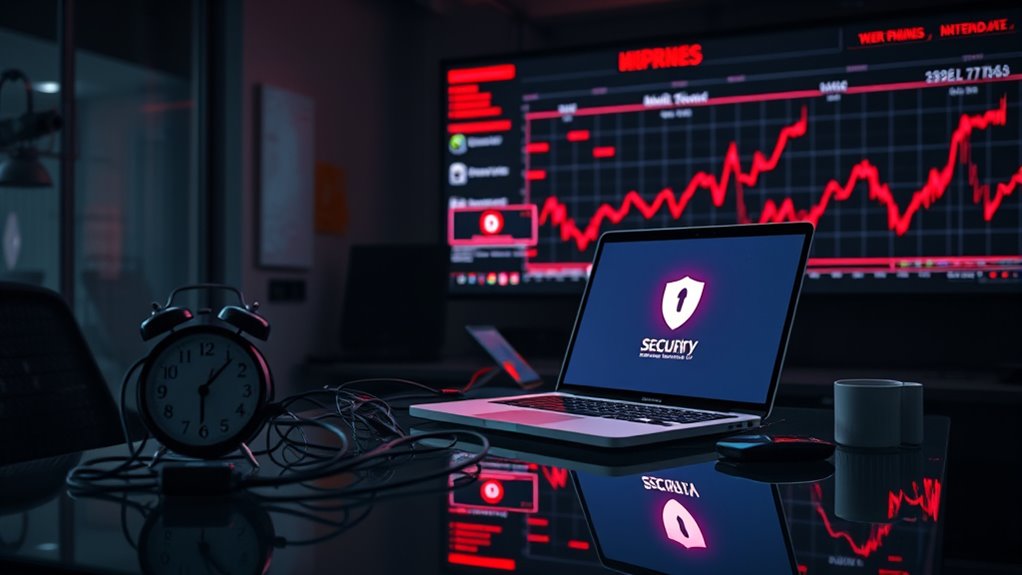
Many experts claim that cyberattacks are increasing exponentially, but the reality is more nuanced. While the number of reported incidents has grown, this rise often reflects better detection and reporting rather than a true surge in attacks. Cybercriminals target data privacy, making breaches more damaging, which heightens the importance of effective risk management strategies. Instead of assuming an unstoppable exponential rise, focus on understanding attack patterns and strengthening defenses. Not all threats are equally frequent or severe, so prioritizing vulnerabilities and implementing proactive measures can markedly reduce your risk. Additionally, the evolving cybersecurity landscape underscores the importance of staying updated on emerging vulnerabilities and security technologies. By staying informed and managing your cybersecurity risks carefully, you can better defend your organization, rather than falling for alarmist claims that may exaggerate the threat landscape.
Examining the “Hackers Can Break Any Security” Claim

The claim that hackers can break any security often fuels a sense of inevitability about cyber threats, but this isn’t entirely accurate. While no system is completely invulnerable, organizations can substantially reduce risks through proactive measures like penetration testing and threat modeling. Penetration testing simulates real-world attacks, revealing vulnerabilities before hackers exploit them. Threat modeling helps you understand potential attack vectors, prioritize security efforts, and strengthen defenses accordingly. These strategies demonstrate that security isn’t about being impenetrable but about being resilient. By actively identifying and addressing weaknesses, you can stay ahead of threats and prevent breaches. Attention to detail is crucial in discovering subtle vulnerabilities that could be exploited by attackers. So, although hackers are persistent, your defenses can be effective if you adopt a proactive, strategic approach.
The Validity of “All Devices Are Vulnerable” Statements

Although the statement that all devices are vulnerable captures a common concern, it oversimplifies the reality. Device diversity means not all gadgets face the same threats or vulnerabilities. While software vulnerabilities exist across many platforms, manufacturers often patch security flaws quickly, reducing risks. Some devices, especially outdated or poorly maintained ones, are more susceptible, but others have robust security measures. It’s important to recognize that not every device is equally at risk, and security depends on factors like updates, user practices, and inherent design. Blanket claims can cause unnecessary alarm. Instead, focus on understanding specific vulnerabilities relevant to your devices and taking proactive steps to strengthen their defenses. Not all devices are equally vulnerable, but awareness helps you better protect yourself.
The Reality of “Cybersecurity Experts Are Powerless”

While it’s true that not all devices face the same threats, it’s a misconception to believe cybersecurity experts are powerless against cyberattacks. They actively develop strategies to defend systems, often relying on employee training to reduce human errors that lead to breaches. Insider threats remain a notably concern, but experts work to identify vulnerabilities and implement measures like access controls and monitoring. Saying cybersecurity teams are helpless ignores the proactive steps they take daily. Your organization can bolster defenses by fostering a security-aware culture and ensuring employees understand their role in preventing attacks. While no system is invulnerable, dismissing the power of cybersecurity professionals overlooks how effective prevention and quick response can mitigate damage considerably.
Separating Fact From Fear in “Cybercrime Costs Billions Annually”

Many reports claim cybercrime costs billions each year, but those figures are often exaggerated. You need to understand the true scope of threats, which are more manageable than sensational headlines suggest. Separating fact from fear helps you make smarter decisions about cybersecurity investments.
Overstated Financial Impact
Claims that cybercrime costs businesses billions annually often exaggerate the true financial impact. These financial myths can inflate perceptions of risk, leading to unnecessary panic. While cyberattacks do cause costs, many reports overstate the economic impact by including indirect or hypothetical expenses. Not every breach results in massive financial losses, and some companies recover quickly without significant disruption. It’s important to differentiate between sensationalized figures and actual data. Overstating the financial impact can lead to misplaced fears and improper allocation of resources. Instead, focus on understanding real risks, implementing effective cybersecurity measures, and evaluating the true costs involved. Recognizing these distinctions helps you avoid fear-driven decisions based on exaggerated claims about the economic impact of cybercrime.
Actual Threat Landscape
The actual threat landscape of cybercrime is often misunderstood because of sensationalized reports that emphasize billions in annual losses. While large-scale attacks grab headlines, many threats are more subtle and closer to home. Phishing awareness is critical because attackers frequently target individuals with convincing scams to steal credentials or install malware. Insider threats also pose a significant danger, as employees with access can intentionally or unintentionally cause breaches. Understanding the real risks involves recognizing that most cyber incidents stem from human error or social engineering, not just sophisticated hacking. Staying alert, practicing phishing awareness, and implementing strong internal controls can help you mitigate these everyday threats. By focusing on these manageable risks, you build a more resilient defense against cybercrime.
Understanding the Limits of “Complete Digital Security Is Impossible”
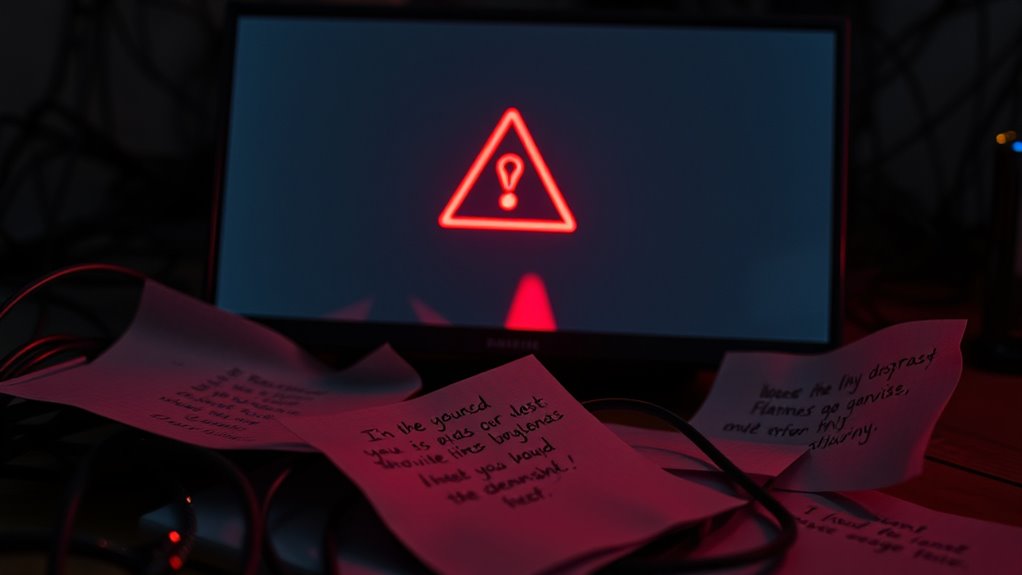
While aiming for perfect digital security may seem like the ideal, it’s important to recognize that complete protection is fundamentally unattainable. No matter how advanced your security measures are, skilled attackers can still find vulnerabilities. Improving your digital literacy helps you recognize threats and avoid risky behaviors, but it doesn’t guarantee immunity. Enhancing privacy awareness keeps your personal information safer, yet breaches can still occur unexpectedly. Accepting these limits means focusing on resilience—regular updates, strong passwords, and cautious online habits—rather than chasing impossible perfection. Understanding that total security is out of reach allows you to prioritize practical protections and stay vigilant without falling into false security traps. In the end, awareness and adaptability are your best defenses.
Frequently Asked Questions
How Can Organizations Realistically Assess Their Actual Cybersecurity Risks?
To realistically assess your cybersecurity risks, you need to understand your cyber risk landscape through thorough threat modeling. Identify potential threats, vulnerabilities, and the impact they could have on your organization. Regularly update these assessments as your environment evolves. Conduct vulnerability scans and simulate attacks to uncover weaknesses. Engaging cybersecurity experts can also provide valuable insights, helping you prioritize risks and allocate resources effectively to protect your assets.
What Practical Steps Can Small Businesses Take to Improve Security?
Did you know 60% of small businesses suffer a cyber attack within a year? To improve security, focus on password hygiene—use strong, unique passwords and change them regularly. Conduct employee training to raise awareness about phishing and safe online practices. Implement multi-factor authentication and keep software updated. These practical steps markedly reduce your risk and help protect your business from cyber threats.
Are There Effective Ways to Prevent Targeted Cyberattacks?
You can prevent targeted cyberattacks by staying vigilant against phishing tactics and insider threats. Educate yourself and your team regularly on recognizing suspicious emails and links. Implement strong access controls and monitor employee activity to detect insider threats early. Use multi-factor authentication and keep your systems updated. By staying alert and proactive, you reduce the chances of falling victim to sophisticated attacks designed to exploit vulnerabilities.
How Do Cybersecurity Myths Influence Public Policy and Investment?
You should realize that cybersecurity myths considerably influence public policy and investment. When misconceptions persist, policymakers may prioritize ineffective solutions or overlook critical threats. Myth busting helps clarify the realities, guiding smarter decisions and resource allocation. By understanding the truth, you can advocate for policies that strengthen defenses, ensuring investments target genuine vulnerabilities rather than chasing false alarms, ultimately creating a more resilient cybersecurity landscape.
What Emerging Technologies Are Most Promising for Future Cybersecurity Defenses?
You should keep an eye on emerging technologies like quantum encryption and AI threat detection. Quantum encryption offers ultra-secure data protection by leveraging quantum mechanics, making it nearly impossible for hackers to crack. AI threat detection continuously monitors networks, identifying and responding to threats in real time. These innovations are promising because they strengthen cybersecurity defenses, helping you stay ahead of evolving cyber threats and protect sensitive information effectively.
Conclusion
Think of cybersecurity as charting a stormy sea. While alarmist headlines may make the waves seem monstrous, the truth is that with the right skills and awareness, you can steer your ship safely. Don’t let fear be your compass—focus on understanding the real threats and taking practical steps. By staying informed and prepared, you’ll find your way through the chaos and keep your digital voyage secure.
Joy, as our Editor in Chief, ensures the highest standard of content. Her talent in writing is complemented by her attention to detail and passion for literature and culture. Joy’s expertise and love for the English language shine through in her editorial work, making each piece a testament to quality and clarity.










